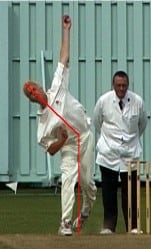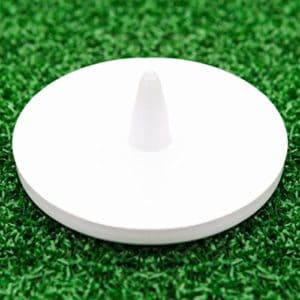I know for a fact that bowlers of all ages struggle with their run ups, and I’ve definitely been there myself too. You might often find yourself wondering things like: How long should my run up be? How fast do I need to run in to the crease? Where do I need to land my feet? And what length should my strides be? If you’re struggling with anything along these lines then I strongly recommend reading the rest of this post so I can give you some pointers!
I’ve done a lot of research on this over the years, especially when I was trying to improve my own bowling technique, and I’ve been able to gather some interesting information that I think will help out a lot of bowlers. In this post we’ll answer the questions that I listed above and examine some of the things that fast bowlers should be focusing on when developing a run up.
Before we start I should say that the importance of doing what feels natural to you cannot be over emphasised! It is my belief that coaches should allow bowlers to develop their own way of doing things, but still be on hand to offer advice and guidance on what aspects of technique should be avoided in order to prevent injury. Take this post as a guide! All cricketers are unique and there are different things that work for everyone!
How Long Should Your Run Up Be
For us fast bowlers the run up is critical as it gives us the momentum required in order to be able to bowl at high speeds when we reach the crease. The question of how long a fast bowler’s run up should be is a complex one and sadly there is no easy answer. Like I said above, each cricketer is different and it is vital to choose a length of run up that feels comfortable for us as individuals.
Most fast bowling run ups range from around 10 to 25 paces in length. There are not many fast bowlers that would have a run up shorter than 10 paces, whereas there are probably more bowlers that would push the upper limit of 25 paces. As I already mentioned, the aim of the run up is to build up a good level of momentum, and to carry that into our bowling action. In my opinion, as long as we build that momentum, it doesn’t matter how far we run before this! That is why I would suggest a length of run up that lies somewhere in between the 10-25 pace range. Anything longer than this could lead to us putting in too much effort during the run up phase of our actions rather than using that effort to actually deliver the ball. We want to save as much energy as we can! Don’t run a marathon before you get to the crease!
A good way to find a natural length for your run up is to practice with a partner on the outfield. Lay down a marker where you are standing, shut your eyes and take off running. Pretend you are approaching the crease to bowl a delivery. When it feels comfortable, go into your bowling action like you usually would and bowl an imaginary ball. Have your partner mark the spot where your front foot landed. If you repeat this process multiple times you should find that after a while you settle on a standard distance of run up that feels natural to you.
Let’s look at a professional example. James Anderson is one of the most successful fast bowlers of all time and has an incredibly economical run up to the crease. His run up measurement is a casual 15 paces, measured from the popping crease to the end of his mark. Anderson is primarily a swing bowler, and therefore out and out fast bowlers may choose to have slightly longer run ups than 15 paces. All that being said, I think that 15 paces is a good place to start if you’re trying to develop a new approach to the crease.
I find that an accurate, repeatable way of measuring out your run up before bowling can be achieved by following these steps:
- Stand with the heels of your boots against the popping crease, facing away from the batsman. (The popping crease is the horizontal line your front foot must not overstep when bowling)
- Take one long stride away from the crease with either foot. This long stride is used to roughly simulate the last stride you will take in your bowling action when delivering the ball, as this is usually the longest.
- From this point continue to walk in the same direction away from the crease. Continue counting the number of paces as you go. These paces should be more of a normal length, to reflect the shorter strides that take place on the approach to the crease.
- When you finish counting to the number of strides appropriate for you, a marker of some sort should be laid down on the field to mark the spot where your run up will begin (Markers will be covered later in this post).
How Fast Should You Approach The Crease
As I said in the previous paragraph, the most important part of the fast bowling run up is building up a good level of momentum and speed before you deliver the ball.
We don’t want to burn too much energy during this phase so you should definitely not be sprinting in to the crease, but the run up should also not be so slow that you don’t build up the speed required to deliver the ball quickly. I like to think of it as a brisk jog.
There are many different methods that work. James Anderson’s run up consists of a gradual build up, finally hitting top speed around the last 6-8 paces. On the other hand, a bowler like Brett Lee is someone that I remember having a much brisker, more intense run up which was quite fast from the moment he took off right through to the delivery of the ball. Perhaps this is one of the reasons that Brett Lee was a faster bowler than James Anderson?
Regardless of the speed of their approach, what both players had in common was the repeatability and consistency of their actions. This is the thing that we as bowlers must work to develop. With both Anderson & Lee speed was built and maintained and used to propel the ball towards the batsman. If you watch videos of them you’ll notice there were no unnecessary hops or short strides or disruptions that could have caused them to lose speed.
There is a very simple drill that I often did to get used to the speed of my run up again after long periods without bowling. All I would do is go through my run up without a ball in my hand. I’d probably repeat this around 5-10 times during a practice session until I was happy that I’d settled on a consistent speed of approach and the run up felt totally natural. Once I’d reached this stage I’d start thinking about where I was actually going to bowl the deliveries!
Importance of Body Alignment – Minimise Movements in Different Directions
There are many different types of bowling action, and many different styles of run up to go along with those actions. All of these give bowlers the opportunity to bowl fast. However, there are technical things that should be considered when developing a run up and bowling action that will help us to become more efficient bowlers and also to avoid injury.
When focusing purely on the run up phase of bowling, it is very simple, try to keep your body parts moving in straight lines towards your target – the batsman! In the same way that a 100m sprinter like Usain Bolt will try to minimise lateral movements and focus all of his energy on keeping his body moving towards the finish line, a fast bowler should do the same thing towards the batsman. Swinging your arms from side to side or having large curves in your run up can lead to you losing pace.
Try to keep your arms relatively tight to your body as you pump them backwards and forwards while approaching the crease, and try to keep your feet pointed directly at the batsman. If you stick to these two things you will find that you can achieve a much more aligned run up. We want to get all our momentum fully behind the ball!
Alignment is also incredibly important during the delivery of the ball, and I will talk about this briefly here (You’ll also find it covered in other posts). Keeping the hips and shoulders aligned as you bowl the ball is one of the main ways to avoid back injuries while bowling. Ideally bowling actions will be either side-on (with the hips and shoulders facing the leg-side), or front-on (hips and shoulders facing the batsman). ‘Mixed’ actions (shown in the photo below), where the shoulders and hips are not aligned, put unnecessary stresses on the spine and can lead to serious injury. These should be avoided at all costs. Your coaches should be able to identify these kinds of flaws in your action and point them out to you at an early stage.

Have a Repeatable Take Off Routine
Having a repeatable take off routine allows you to consistently take off from the same spot when bowling. Bowling is all about repeatability, getting into a groove and getting used to your own action. If you can ensure that you start your run up from the same point before you bowl each ball, then the more confident you can be about where your front foot is going to land on the popping crease. The more confident you can be about where your foot is going to land then the less you have to think about potentially overstepping as you approach the crease. Whenever I wasn’t sure about my run up during games, it would impact the speed of my bowling because I’d be worried about bowling no balls. This caused me to slow down my approach or take smaller strides to make sure I got my foot behind the line, which killed all my momentum!
To ensure you have a repeatable take off routine, there are a few tips I think that will help you:
Make Sure You Take Off From The Same Foot Every Time
I think this is the most critical part of ensuring a consistent take off. When you find a length of run up that is working for you in practice, stick with this and take note of which foot you are taking off from. This is one of the most effective ways of making sure your stride patterns are consistent every time you approach the crease.
Lay Down a Marker Once You’ve Measured the Paces of Your Run Up
Your take off point should always be from a specific distance from the popping crease. Like I mentioned earlier in this post, once you have measured out the paces of your run up, a marker should be laid down on the ground in this spot. This can either be a physical marker like you can see in the photo below, or you can make a mark on the grass with your spikes. Both do the trick!

Decide Whether You Want To Start Your Run From the Marker, or Just Behind It
Once you have the beginning of your run up marked out clearly, you have a decision to make. You can either stand on that mark and start your run up directly from there, or you can choose to have a few introductory steps before your take off foot reaches the marker. I prefer to take a few small steps just before I reach my marker to get my feet moving. I feel like it makes it much easier to get into my rhythm rather than starting to run from a dead stop.
Be Careful How You Land Your Feet
Some bowlers develop injury issues caused by how their feet land during their delivery stride. This applies particularly to the front foot (left foot for right handed bowlers, right foot for left handed bowlers). When a fast bowler is bowling, their front foot takes much of the load as it slams down onto the pitch. In this moment, the ankle and knee joints can be required to support around 15 times the bowlers weight. This means that if your feet end up in a bad position when you land, then there is a high chance that you could get injured.
I remember the chronic ankle injuries that plagued Andrew Flintoff throughout his career were not helped by the fact that when his front foot landed it was often on an angle, rather than pointing straight forwards. The angle of the foot meant that the ankle was in an unnatural position while all of this extra force due to bowling was being passed through it, and the joint couldn’t cope. A more technically correct foot position can be seen in the photo below. You can see that the toes are pointing directly towards the batsman.

If you experience pain in your feet/ankles while bowling then get your coaches to have a close look at your run up, and they may be able to give you some helpful pointers. I mentioned the importance of alignment earlier and this is also true with the ankles, so always try to keep your feet landing in comfortable & natural positions if you can!
Lastly…The Importance of Practice
The only way to get your run up right is by practicing it over and over again. It takes a long time to get a run up ingrained in your muscle memory so much so that it feels totally natural. If you are trying to change certain aspects of your run up, then try to change one small detail at a time. Then focus on getting used to this new element of your technique before you move on to the next thing.
When trying to find the perfect length for your run up, practice sessions are invaluable. Once you have a number of paces you think is appropriate, have someone watch you to see if you overstep the popping crease when you bowl. If you do, then you can move your marker back a little bit in order to take this into account. Once you’ve ironed out these small little issues through multiple practice sessions then you should be able to go into games knowing that you won’t be bowling many no balls.
